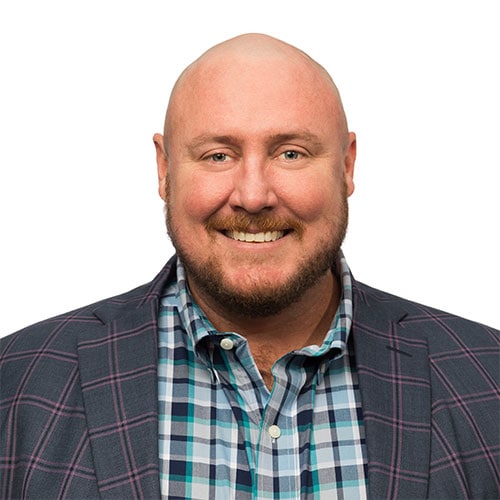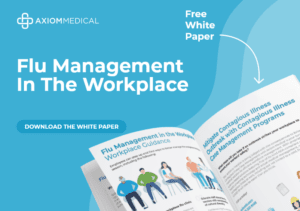[00:02] – Holly Foxworth
Hello and wow, what a week it has been already. Good afternoon. Thanks for joining us today for the How to Maintain Business Operations or your workplace operations with a massive influx of COVID-19 cases. In case we haven’t met, my name is Holly Foxworth. I am a registered nurse and the marketing manager for content here at Axiom Medical. I’m also joined by our CMO duo. We have Dr. Scott Cherry, our Chief Medical Officer, and we have Derek Wheeler, who is our Chief Marketing Officer. So they both really bring a lot of different perspectives to the table. We have the medical, but then we also have Derek, he’s a really close finger on the pulse of what’s going on in the market, interacting with our clients and our partners on what’s working, what’s not, and where we need to go and kind of go from here. So I’ll definitely introduce you guys to them momentarily. I will say that we’re pretty straight shooters here. So when we came up with the topic for this week of how it is that you’re going to maintain your operations, I don’t think we had any idea that we would soon get to practice what we preached this week, but we found ourselves also in the same scenario is what you likely have as well with production needs that need to increase. I think we’ve had something like a 500% increase in the production, the operation needs that we have, while also dealing with the same issues that you guys have of the employee strains from the variant and from the symptoms that they’re experiencing. So that is actually where we’re going to go with this today.
We’re going to give you kind of an update, then we’ll come touch on what’s actually occurred with us and some of the strategies that we’ve utilized to keep things afloat so it’s going to be a great session. Definitely a lot of questions, I would assume. I did want to kind of go through just quickly what you’re looking at there on the platform. The main thing that you’d want to focus on, where it has the most engagement really is at the top right-hand side. And that’s where you can submit your questions. So if you have anything that you want to share, if you want to ask anything about vaccines, about updates, OSHA ETS, you name it, we’ll be happy to cover those. We’ll try to pick them up while we’re actually in the event. But if there are some that come at the end, we may take those as well before we wrap up. So I think that’s kind of the primary things for me to mention in terms of announcements. Let’s go ahead and have our panel introduce themselves. Dr. Cherry, do you want to go first?
[02:33] – Dr. Scott Cherry
Sure. Well, good afternoon. My name is Scott Cherry. I’m Axiom’s Medical Chief Medical Officer. My professional background is I’m board-certified in preventive medicine, public health, and occupational environmental medicine. And I’ve been supporting the military, government, and corporate and industrial operations for the past 15 years. And it’s a pleasure to be with you.
[02:55] – Holly Foxworth
Thank you. We have put him to work this week for sure. All right. Derek, would you like to introduce yourself as well?
[03:03] – Dara Wheeler
Yes. Thank you, Holly. My name is Dara Wheeler. I’m Axiom’s Chief Marketing Officer, and I appreciate everybody joining us today. As Holly said, we’re here to discuss a lot of challenges that we’ve all been facing over the last few weeks and especially this last week. And in addition, Axiom is really thankful that we’ve had a lot of support in these moments of crisis ourselves. So we really appreciate you all joining us today.
[03:29] – Holly Foxworth
Absolutely. I couldn’t agree more. All right. So just to kind of give you an idea of where we’re going to go with this today and some of the information that we’re going to discuss, we’ll obviously start out and try to give you an update on where we stand, what these projections are looking at. Then we’re going to come and bridge over to the difference in some of the guidance that came out. CDC has made some recent changes. And so we’ll go through those kinds of speak to the state-specific guidelines and then also what that would look like if you were to elect to go to a more conservative risk management type of model there. Then we’re going to talk through crisis management and business continuity and then wrap up with discussion of what could be on the horizon with some of these headlines, the co-infection of flu-rona, and then also the additional variant that was mentioned this weekend and that was recognized. So let’s go ahead and get started. Dr. Cherry, do you want to just talk to us through where we’re at where we stand with the cases and kind of give us some context in terms of the zoo that we’ve all kind of faced this week.
[04:37] – Dr. Scott Cherry
Yes. You know, so we were somewhat bracing for Omicron since South Africa had reported really huge spikes in their cases and how it displays Delta quite quickly back in probably late November. And so what we see here is kind of on January 5th, a really large number or spike of cases. And I believe this is New York. But when we look at the US globally or nationally before the Omicron spike, we were seeing roughly about 100,000 cases per day. But now with Omicron, the spike now is up to about 700,000 cases per day. So you’re seeing about a 5X increase in cases across the country, with some States with actually a 10X in their cases. So really a very dramatic increase in cases. And we were looking at South Africa and their experience to see how long the surge lasted to help us kind of prepare for what we would see here in the US. And so I think the information we can glean from them was about six weeks but I’ve also received some information that they may have stopped fully testing or they changed their approach once there was such a massive surge that had overwhelmed them.
[06:18] – Dr. Scott Cherry
So the surge may actually be a little bit longer than anticipated. Still to be determined but it looks like we’re just starting to see the peak of this, which is really quite dramatic. And it’s made me think back to my military training with regard to kind of disaster medicine or mass casualty events. And so I think we’re almost kind of there in the sense of thinking along with these very extreme events where a disaster essentially overwhelms the medical system, whereas a mass casualty event kind of fully saturated the local resources. And so I think we’re hovering somewhere between there, not necessarily for the hospitals, but I think for businesses in general where you’re going to potentially have so many people out of work, it may not be feasible with your current approach to this to maintain operations. That’s at least what I’m kind of brainstorming in the back of my mind.
[7:29] – Holly Foxworth
Yeah, definitely. The other thing I was going to ask about is there’s been a lot of talk about when we think that this peak will come and could you speak to that and then also explain that after that peak hits that you also then have that set of decline that goes down. So it’s not like it just goes away within a matter of a few days. What would you anticipate from that type of perspective?
[7:56] – Dr. Scott Cherry
Could you repeat the first part of the question? I missed a keyword.
[08:01] – Holly Foxworth
Yeah. No, I was actually just asking about future projections and what your thoughts were about. There’s been a lot of discussions, a lot of ideas on when we think that this could be a peak. But it feels like some people are kind of getting confused that we’re aware even if you had the peak when that occurs and it also continues to go downhill or even continue to have cases, it doesn’t just end at the very beginning. Is that your understanding as well, Dr. Cherry?
[08:29] – Dr. Scott Cherry
Yeah, I think we have this current slide up. So there are two to three other peaks here that if we look at the winter of 21, basically December 21, that peak, or that surge started almost back in mid-September and didn’t finish until February or early March. So although the peak occurred probably right around January, that’s kind of the maximum. But you’re going to have this normal distribution that you see that unfolds that takes maybe between six weeks and two to three months. So I would expect Omicron to be similar. You know, what we’ve seen from a virology perspective, is there’s really this accelerated course of infection, really tremendous infectivity and then reproduction, reproduction in each person with very high viral loads very early on and usually clearing sooner. And so I think we could almost assume that this would be a shorter surge in general, maybe at the six-week period versus three months, but because it’s so infectious, it may actually kind of draw it out. So it’s really kind of at this point guessing because it’s so early on.
[10:26] – Holly Foxworth
Yeah, definitely. Yeah. Well, kind of transitioning over to that just one with us. There’s been a lot of discussions this week about some changes that were made by the CDC in terms of what they felt was appropriate for isolation. There’s been talk about testing, etc. And then we had the additional layer of some States that have their own guidance, and then you have the additional layer of what is typically best practice with a more conservative type of model. Could you talk through what some of these changes are and how the different guidance varies?
[11:05] – Dr. Scott Cherry
Sure. I think early in the pandemic, the focus was on almost zero risk of infection. And so when the CDC put out its early guidance on symptomatic or testing positive people were out 14 days. And then over time, they shortened that duration to ten days. And then it also allowed for some type of testing to allow people to return to work or to discontinue social isolation earlier with negative testing. And I think at that point, I started to intuit that the CDC was shifting from kind of this zero risk of infection from the protocols to some maybe small percentage, which trying to get to zero risk is very difficult in many ways, theoretically and obviously practically. But recently the CDC has shifted now to something that I think a lot of people have had some concerns about, going from kind of a ten-day isolation protocol for those that are, again, symptomatic. Presumed positive or test positive to a five-day isolation period. And so, again, that’s been challenging for the CDC to defend. And so we have seen States come out with their own specific guidance really contravening this change and maintaining the status quo of ten days.
[12:58] – Dr. Scott Cherry
I think the biggest pushback as there’s no testing required to allow someone to return back at half the duration of the previous kind of standard that was set. And so I think the leaders of the CDC have stated that this current protocol introduces about a 10% risk of kind of lingering infection. And that can be concerning in many ways because of Omicron being so infectious that say you allow this 10% risk of infection, it can really spread quite quickly through your workforce or through other organizations, whether it’s social, work, personal, things like that. And so just kind of some discussions about that, too, as I’ve always, in my professional career, advised either military commanders or corporate leaders on what’s the risk-benefit from a medical perspective. And then usually you’ll have a multi-stakeholder approach committee that looks at how an organization can move forward, taking into consideration the medical guidance. But also all of the other drivers with regard to risk, continuity of operations, etc. So this new CDC guidance, I think, is actually taking some medical guidance, but also allowing or also providing operational guidance, too. And I think every company should actually be the custodian of their own risk tolerance. And so it’s 10% too much for them because it can potentially lead to outbreaks that they can no longer control or maintain a certain operating ability. I think that’s kind of the biggest take for me on this new CDC guidance, but I’d like to get Dara as an input onto this just to see if there were any aspects I hadn’t addressed or if she has other input as well now.
[15:19] – Dara Wheeler
No, I think that’s all really interesting. And I do think that risk tolerance is really something that an employer has to evaluate because your employee populations are unique to your business and your industry. And there’s a lot that should be considered around just even the environment that your employees are working in, their access to spacing and masquerading, and all the other environmental controls that you may have in place. Also, the type of population that you have, whether they’re at risk within that population, if you have a population that’s a little older or has other underlying health conditions, not that old is an underlying health condition, but it feels like it sometimes so that you should be paid attention to what your population is dealing with. And so when a government agency or recommendations come out, they are guidelines. And I think that’s something that we as an organization have taken very particularly to heart, that these are guidelines. These are not hard and fast rules for every organization in every industry. And so while this is a national guideline and there are some industry guidelines for healthcare workers and for some other industries that an employer needs to consider all these different factors when putting a protocol into place.
[16:46] – Dara Wheeler
And also, as Scott said, the biggest challenge for all the employers we work with has been balancing that risk with maintaining operations. And when Scott started at the beginning of the conversation by saying, we do recognize Omicron is highly infectious, potentially less severe. But as an overall business environment that we’re dealing with so many cases, the biggest challenge right now is just keeping the doors open and keeping employees healthy and safe at work. So I don’t think we put this in the slides this week. And those of you that have been around us for a long time know that we talk about the layered approach constantly. And I do think like we’ve got on the slides here, paying attention to those environmental controls, your testing protocols, all of your different protocols, and continuing those layers is so important. And it’s not just the five days, the test out, the mask-wearing, it’s considering your population and protecting them the best you can within the parameters you’ve been given.
[17:51] – Holly Foxworth
Absolutely agree, yeah. And one of the questions that we got in a lot this week was whenever you go through the CDC guidance that was there, they had mentioned that you would have the five days and that testing wouldn’t necessarily be required to return to work. However, then it follows that by saying that if you do test, then you should remain in isolation for an additional five. I think there’s a lot of confusion, I think, around what messaging is and what best practices. You’re absolutely right about that. Everybody needs to make their own – what works best for their individual workplace.
[18:28] – Dara Wheeler
Sorry. Real quick, Holly. I’ve heard Dr. Cherry say this and some of the other doctors that we work with. And I think just to reiterate this one more time when you have messages coming out like this that are very conflicting and confusing, there’s so much media and news out there and stories. And I click on things all the time because there’s some highlighted title that I’m like, wait, what? And I think that making sure that your resources and the people you’re partnering with have the information and are kind of weeding through what to pay attention to and what not to. I think it just becomes more and more critical to remind everybody at this time to just take a breath, and we’re all trying to get through this moment and all of these changing messages together.
[19:19] – Holly Foxworth
You’re exactly right. It did look like there were some questions that came through. I think Robert was asking about some of these specific maybe State requirements that were there that were holding to the ten-day quarantine. And then let’s see, it looks like there was one more that was asking. Have any of the States challenged the new CDC guidelines or recommendations there? Either you have commented on that or one could provide some additional context.
[19:50] – Dr. Scott Cherry
The ones I’m aware of off the top of my head are California. I think Cal-OSHA actually has issued their requirement going back to kind of ten days of isolation for those that are infected. And I believe also New Hampshire has also not moved from its original stand. And from an authoritative or enforcement perspective, CDC is an advisory agency, so it technically doesn’t have the force of law or enforcement. When you see agencies like OSHA get involved, then that’s obviously whether it’s federal OSHA or State OSHA that does actually have kind of a much more force applied to its guidelines or requirements. And so that is something to be aware of. And I’m not sure Dara if you’ve heard of other States at this point. I was looking to see if actually, the CDC was going to pull back its guidance, but it does look like they’re going to stick to the current updated guidance that they’ve provided based on Dr. Walinsky and Dr. Fauci’s comments this past week. But I’m not sure if multiple other States will kind of go along with the old guidance or if they’ll actually have even more nuanced guidance?
[21:24] – Dara Wheeler
Yeah, I think as Scott said, there’s a difference between a state-run OSHA. So there’s a handful of States that have their own OSHA entity that’s been approved or been enabled by the federal OSHA, and California is one of them. So there are these state-run OSHAs that have issued their own guidelines and own processes, and then a lot of the States are either choosing to remain silent for now or wait. As I said, I think a lot of them are waiting to see if the CDC decides to keep this protocol in place or this recommendation in place. And I think we’re just going to have to see how this progresses. But like Dr. Cherry said, if you’ve got guidance so an employer can decide whether to adhere to that guidance or not based on their own situation. But then when you have a state-run OSHA entity, like a Cal-OSHA, then that’s got a little bit different enforcement capabilities than a recommendation through the CDC for the client that asks that we’re happy to give you a final list and send that to you.
[22:36] – Holly Foxworth
I agree. Yes. Even some of the guidelines that are there, unless I’ve missed some part of it, I wasn’t really surprised by any of those recommendations that were there. Some of the more conservative from the State level. It seemed like they were just addressing the continued issue of promoting health, promoting getting vaccinated boosters, social distancing, masking, etc. Are either of you aware of anything outside of those that may exist within State guidelines?
[23:12] – Dr. Scott Cherry
No, I’m not. I think it’s essentially just pushing back on this newly updated guidance.
[23:17] – Holly Foxworth
Yeah. Great. All right. And then let’s see. Michael, I see your question. We’re going to get to you in one second whenever we get to the shutdown piece and talk about business continuity, but just kind of moving in that direction. I’ve mentioned to you guys before that we kind of have a taste of our own medicine, that we’ve had to practice what we preach in terms of being agile and being able to pivot quickly. So Dara or Dr. Cherry does either one of you kind of start here and just kind of talk through what that looks like in a perfect world where that crisis management lives, but then also what you need to do to actually keep that on track, especially when you have such strength conditions of what we’re currently experiencing.
[24:03] – Dara Wheeler
Yeah, I’ll start and I’ll let Dr. Cherry jump in and of course, plans. We need to have policies and processes in place. And like Dr. Cherry said, we were planning for a spike in cases. So as a business, we started tracking Omicron as a variant. Pretty early on, we’re reading all the studies out of South Africa, looking at the UK to kind of model out how this would affect our business. And we had a plan and we were executing on that plan. Now, this has definitely hit us a little harder than we expected. So then that’s where the agile and the innovation and the disaster triage planning comes in, where you’ve got to then pivot really quickly and figure out how to support our own employees and our clients through this. So that plan was great and it is still a valid plan, but this definitely had a scope that I think none of us were quite ready for. And so it could become a continuous risk assessment and conversation. And just as an executive team and a leadership team at this company, we spend a lot of time communicating and collaborating on the next approach and making sure we’re delivering everything we can for both our own employees and our clients’ employees because we do recognize how critical this all is to the US right now. And then I’ll let Dr. Cherry speak a little bit about what he was speaking to around some triage and trauma protocols and how we think about pivoting in times like this.
[25:48] – Dr. Scott Cherry
Yeah, maybe I’ll just touch upon some of the strategic thoughts to consider what I’ve seen in kind of military contingency planning. There are really two kinds of scenarios to think through, kind of a most probable event, which probably gives you based on your estimation, kind of within a certain tight, narrow window of what to expect during a certain type of an event, but then actually having kind of a maximum credible event, too. So you have kind of a reasonable expectation of what’s going to happen even with a little bit of uncertainty put in there. But then you actually have kind of this very extreme within constraints, but really this maximum credible event. And so I think this is a perfect example of that where we were bracing for Omicron to displace Delta and expect surges because of Omicron, but also because of winter seasonality, things like that. And so maybe you had a rough estimation of 2X, 2.5X of what was previously we were seeing from a caseload perspective. And obviously, with Omicron, we’re seeing at least 5X on average across the nation, but probably 10X in different areas. And so again, utilizing these two types of scenarios, it’s really to have you stay at the ready for what to practically implement from a resource allocation perspective, but then also have what if things really go off the rails.
[27:40] – Dr. Scott Cherry
So again, I think that with Omicron, especially what’s really key or with really any kind of disaster planning is actually having reassessment and it being a very dynamic situation where you look and we might be thinking, okay, 10X is almost too much to handle, but it could still go to 15X. What do we do? Or what if 10X is sustained beyond a few weeks or a few months? And so we are obviously doing that as our own organization and advising our clients for their own specific operations. And so I think there are several different levers to pull here. You can think of them as kind of internal in the sense of maximum controls for infection. And so, for instance, if you haven’t utilized the whole layered approach with regard to environmental controls, testing personal protective equipment, vaccination health at test stations, you really would strongly be considered utilizing all those as possible. But then you can still push each lever further.
[29:10] – Dr. Scott Cherry
So, for instance, if you do require masks, there have been studies now that have shown there are different levels of effectiveness for masks. And so obviously, the N95 mask is one of the most effective means. So if you’re using surgical masks, then perhaps shifting to N95s, especially if you have forward-facing employees that are interacting with the public, or if you have employees in close contact with one another, especially because of this high infectiousness with Omicron, or if you’re utilizing the shorter duration guidelines for bringing people back sooner, at the same time, continuing to look at risk stratification of your workforce. Dara had mentioned that already about the vulnerable populations. And so potentially as a kind of a maximum credible event. So say, for instance, we go to 20X for quite long periods of time, there may be really difficult decisions to make about, well, if those certain populations that are at low risk of severe disease, maybe we keep them at the front lines despite infection. And obviously, that’s extreme and needs to be fully vetted through a multi-stakeholder approach with risk HR, safety, operations, executive leadership, etc. But really having that in the back of your mind of what if this really becomes kind of something that we need to deal with for much longer than we were hoping to expect. And so I think I’ll pause there and just see if we have any other pieces you’d like me to address, Holly or Dara?
[31:12] – Holly Foxworth
I do. I actually have questions for both of you. So since you’re already here, I’ll come to you first, Dr. Cherry. Whenever we talk about the triaging and prioritizing needs, it seems like we’ve seen very clearly we come to see it on the news or in some of the publications that it’s an issue. It’s an issue with everybody right now. You’re saying and just like the question that was asked in the very beginning from Michael, was this really an option that somebody may have to shut down their operations solely because of the influx of cases that are there. So I wanted to ask if you would cover that a little bit more in terms of what does that means to make a decision about triage? Does that mean that you could compare that to a hospital that is overrated with lots of people, they have a limited number of beds. And so then you have to start making decisions of who would be most critical? Or could you kind of give us a reference from a visual point there of what that would look like from a business perspective?
[32:21] – Dr. Scott Cherry
No, thanks for bringing that up. I knew there was something else I wanted to address, but I had been talking for so much, I had kind of lost it in my book. But I really appreciate that. Again, we’ve addressed kind of the internal levers for protection, but really a key strategy is to look at your triage protocols. And so obviously, that’s something Axiom does for our clients, where we have best practices that span the continuum of very protective, which is our Axiom standard. But we have a lot of exception protocols based on client needs or specificity to our clients, where they will opt into different exception protocols. But one of the most important aspects of screening or triage is to be able to actually manage or at least do a quick assessment on everyone. So, again, we are almost on the brink of mass casualty from a case perspective or even getting close to disaster, where almost not every case will be able to be assessed when you look at it from a holistic perspective. So really just change that triage whenever there’s a mass casualty to where if someone collapses in front of you and there’s no one else down, you can actually spend all the time and resources for that one person. But if ten people fall in front of you and there’s only one of you or if there’s 100 and obviously you see the trend here. So for Omicron, if we’re seeing close to a million cases a day if businesses need to be able to sort through which employees can work and which cannot, there really needs to be this nuanced decision very dynamically depending on kind of the caseload to where maybe you look at your exposure protocols, your symptomatic protocols, and you simplify them based on expediency and the ability to manage huge volumes of cases. And so that’s absolutely critical. And really it’s really coming from disaster medicine or military medicine, but I think it almost can apply here at least some of the principles.
[34:42] – Holly Foxworth
Yeah. And then, Dara, I was going to ask you actually if you would kind of speak to one of the big focuses that we’ve had this weekend is transparency and communication. Do you have any recommendations for those that are joining today as to what that looks like to be able to frequently and fluently communicate what your status is and where you’re at and your kind of expectations?
[35:09] – Dara Wheeler
Yeah. I think this has been another interesting theme for us over the course of I think, most of our webinars. And when those of you who have joined and heard our Chief Legal Officer speak about things like the OSHA ETS and all of these different changing legal and government and compliance requirements, I think that even internally, as things are changing, being as transparent as possible with our teams and communicating what we’re doing and why and how I think is important, and then making sure that that translates to all of our vendor partners and relationships and making sure that from the top down. Our CEO, Mark Robinson, is a big proponent of this as well. And we do a town hall internally every week, allowing everybody to join, ask questions, and talk about the state of the company. And we’re doing that as much as we can with clients and partners as well. So I do think that in situations like this, communication cannot be overstated. It can’t be over communication. It needs to be frequent. It needs to be fast. It needs to be clear.
[36:19] – Holly Foxworth
Absolutely.
[36:20] – Dara Wheeler
Before we get off this topic, I want to go back to something Dr. Cherry said. Doctor Cherry, you were talking about masks and a layered approach. And if a client hasn’t evaluated the mask types and what their employees are wearing and some of the studies around K95s and N95s, and one of our listeners, Teddy, asked, and it was something that you and I actually spoke about this morning about OSHA’s requirements for fit testing and medical evaluations for respirators. Can you kind of weigh in on what that would mean for a client issuing guidance on mask-wearing?
[36:56] – Dr. Scott Cherry
Sure. And I think maybe I’ll just set up the value kind of using an N95. And so healthcare workers who are taking care of COVID positive patients or any other respiratory illness when they’re wearing an N95, they’re in the room technically exposed, quote-unquote. But essentially, we do not consider them exposed because they’re utilizing they’re under what we call a respiratory protection program, which has several aspects to it. The key one is obviously using the proper respirator N95 mask, which has a certain efficiency of essentially filtering the air that’s breathed in. And they’re quite effective, really. And so for someone who’s wearing an N95 for work in a professional manner, there are several criteria that need to be completed. One, they need to be medically cleared. So OSHA has a respiratory questionnaire, which is kind of the minimum. But there can be other aspects like pulmonary function tests, things like that. The other big component is a mask fit test. And so for those that have worked in hospitals every year, they will actually go through a mask fit test, which actually will either qualitatively or quantitatively give you the effectiveness of that mask.
[38:28] – Dr. Scott Cherry
And so, again, there are several components to it. It’s not something that’s just easily rolled out. But if we really are seeing Omicron coming up through our worker populations and with all of the things we’ve tried from the CDC recommendations, etc, that have really not allowed for it to be contained, this may be one other consideration. N95s are a kind of standard equipment for health care workers, but also for other types of workers that we support with regard to dust in the workplace. And I think a lot of people who haven’t worked in dusty conditions, kind of seems like a minor exposure, but it can really be a major exposure. And there are actually several different work-related illnesses with regard to deposits of dust in the lungs. And so, again, this is something that is potentially not been highly publicized but could be a difference-maker as one key component to preventing Omicron being spread so quickly and severely.
[39:53] – Holly Foxworth
Yeah. Just kind of getting back to basics because I think that we also kind of have some questions in this area as well. Can you define what it means to have exposure at this point?
[40:07] – Dr. Scott Cherry
So that hasn’t changed in the recent term. Still, close contact is defined as within 6ft and 15 minutes. I think potentially, though, for Omicron, it’s so highly infectious that it can really challenge those parameters, so to speak. And so I think we’ve heard anecdotes at least that just spending a very short period of time within 6ft could be. And so these are probabilistic guidelines. So if you’re greater than 6ft in less than 15 minutes with someone, then the probability of you having an exposure that leads to infection is low. And that’s with the other variants, I think with Omicron being so highly infectious, that almost could challenge those rules, but we just don’t have good data yet that would support changing them.
[41:23] – Holly Foxworth
Yeah, good point. Just several other questions. It looks like what Tony was asking about, do you have to disclose who is positive to other co-workers in the workplace? Does either of you want to take that one?
[41:43] – Dr. Scott Cherry
I know there’s contact tracing that’s invoked, but I don’t think necessarily the source has to be named, but I probably would either defer to Chuck, our Chief Legal or HR person. But unless Dara, you know, off the top of your head.
[42:03] – Dara Wheeler
I think typically contact tracing guidelines encourage keeping the privacy of the individual paramount. However, you do need to communicate that there was exposure and even some State guidelines. I do believe Cal-OSHA has some pretty significant guidelines around this. And at what point do you need to shut down an office and or start testing people on a regular basis if there was a workplace exposure confirmed.
[42:34] – Holly Foxworth
Let’s see. It looks like I saw some others that came through that may be related to this, and we may pick them up on the backside. Everybody that was asking, it looks like you had a lot of questions asking for those State guidelines. So we will actually send out an update following those events so you can have that kind of as a reference tool. One question that I did notice here was that Lee was asking, given that the home and rapid test have a 40% false-positive rate, should we require PCR tests for effective staff to return to work.
[43:10] – Dr. Scott Cherry
I can speak to this a little bit. And testing is actually quite a difficult science in itself. What I would say is a lot of people focus on the difference of sensitivities between PCR and rapid test, and indeed, PCR does have a higher sensitivity. So sensitivity is the ability to detect the disease if it is there. One other kind of highly nuanced principle is called positive predictive value, which is not necessarily an inherent property of a test, but it’s looking at the test and the population that that test is applied through. And so one of the challenges, regardless of whether it’s a PCR test or a rapid test, is if you’re doing that test in a population that has a low prevalence of a low pretest probability, you do run the chance of getting false positives. And so I don’t think there’s a remedy that I can come to that can break through that, except for having some kind of protocol that deals with potentially dealing with a false positive test. The other component usually is before medical surveillance for COVID. Usually, doctors will only order tests when there’s kind of above a certain pretest probability that the test is going to be positive. And so I know that answer can kind of be unsatisfying in several ways, but that is a function of both tests and low prevalence situations.
[45:17] – Holly Foxworth
Yeah. Let’s see. It looks like we had several more that came in. One was asking about recommendations for employee compensation. So we’ll definitely follow up with you after this lease as well. And then we did have one more that I was going to kind of run through you guys, which was Nader. At least that’s how it’s spelled. I apologize if I slaughtered your name on how you say it, but was asking, do we need a vaccination policy?
[45:49] – Dr. Scott Cherry
I think talking about vaccines as a tool is actually probably a good topic to spend a few moments on. And so, obviously, from the beginning of the pandemic, once operation warp speed was able to produce vaccines, they have always shown a great benefit to prevent severe disease, hospitalization, and death. I think as variants came through, we started seeing a decrease in the effectiveness that was originally seen in the original studies, but still showed a fairly good amount of protection, again, from severe disease and death. The question I’ve always had is how effective are they at preventing just infection? Because that’s one of our primary goals in supporting our clients. Continuity of operations is actually just cases, case prevention, not necessarily severe disease prevention. The early studies actually did not even address that, or at least they did not publish it. So I knew that evidence was not yet available. And so our Axiom standard had always been doing not treat vaccinated and unvaccinated differently because, again, we could not show from an evidence-based perspective that those employees would be protected and so now going through a few different variants, Omicron has actually shown the vaccine to be quite ineffective.
[47:33] – Dara Wheeler
In fact, one of the recent studies out of Ontario looked at those that just had a two-dose series of messenger RNA vaccine really had almost no protection, and those who had a booster had about 37% protection. And so we’re seeing really very low effectiveness with vaccinations. So although it’s still, I think on an individual basis, something to strongly consider and discuss with your physician from a population health perspective, especially in the context of Omicron, it’s not the highly effective tool from infection prevention that we would want it to be really just a game-changer, so to speak. And that’s I think what we’re saying, we’re seeing outstanding outbreaks of both unvaccinated and also vaccinated. So a good kind of silver lining here or relative good news is it does look like there’s still mounting evidence of lower severity in general for each case. But I do worry about because of such high case volume we still will see our hospitals somewhat overwhelmed just based on such huge volume. So it’s a weird time for me, just professionally, to think how the vaccines have kind of waned in their effectiveness. But then also Omicron in general, it just seems to be less severe even in the unvaccinated on average. Obviously, there are going to be severe cases and deaths from this still.
[49:23] – Holly Foxworth
But you’re not recommending, though, that we would refrain from recommending vaccinations, correct? You’re just saying that they may not be as effective for this particular variant as what they were for maybe some of the others.
[49:36] – Dr. Scott Cherry
Correct. I think the CDC guidance for fully vaccinated and boosters should still be considered. But through my lens of helping clients help navigate risk, it’s something that, again, is still part of that multi-layered approach. But the effectiveness tends to be much lower than what we used to expect it to be. And so it’s tough to recommend treating vaccinated versus unvaccinated differently in employee health-protective policies.
[50:14] – Dara Wheeler
I think this entire trajectory of vaccination creation for COVID and kind of as we’re thinking through this. And I know I’m not going to make Dr. Cherry give any sort of conjecture, but I think early on we thought this may end up looking similar to the way we handle flu and influenza vaccines every year where you’ve got different strains and you’ve got different approaches to those strains by developing a new vaccine or a couple of new vaccines every year. So we just maybe in this cycle. And again, I’m not going to make Dr. Cherry weigh in on this, but we’re early, we’re still early through this whole experience and cycle. So we may be in a situation where we are developing new versions of the vaccine on a regular basis. So to be determined,
[51:01] – Holly Foxworth
Definitely, yeah. Kind of the one last point that I wanted to touch on here was some of the news that has made the headlines a lot this week. It looks like there was another variant that was identified. And in addition to that, we’re now seeing flu-rona that is being discussed where it’s a combination of COVID and the flu. I think early this week, in the very beginning, we were thinking, oh, well, that’s somewhere else. I think Israel is where we were looking, but it does look like there have been several that have been reported in the US as well. Could you talk through those and just kind of give us the highlights of where we stand or what we know at this point?
[51:41] – Dr. Scott Cherry
Yeah, I think the IHU variant actually, I think it’s been around for a couple of months or maybe three months. So maybe around the time, even Omicron was out. But it really hasn’t gotten the traction that Omicron has. Omicron has essentially taken over. It’s the predominant variant across the world. The EU variant, I think, was discovered in France and there are cases there, but I think it’s just maybe tens to hundreds of infections there and maybe in some other countries. But I think what is more important is that variants are probably going to be expected versus I think early on, every variant was very scary and we didn’t really know what to expect. But really with coronavirus the way it’s an RNA virus that has really a big chance of creating its own mutations as it reproduces, it’s probably going to be kind of something to be expected. A fellow peer of mine, we were discussing this a little bit, and he quoted that he expected roughly a new variant of concern or interest to be generated for every 50 million infections. So that’s an interesting way to think about it. So if the US is generating 700,000 cases a day right now and those are undercounted. And those are people that actually are in a kind of formal system that’s either getting tested or is under some syndromic surveillance. But there are probably some multiple of cases that are not being formally tracked or getting tested. So you could easily see a million-plus case per day just in the US. So when you extrapolate that across the world, variants are going to be created just in general. So it’s to be determined. Yeah, go ahead.
[54:08] – Dara Wheeler
Sorry. Go ahead. I just had a quick question for you about variants. I only play a doctor on TV sometimes. I got my medical degree somewhere. I get this question a lot from colleagues and friends and family members about variants. And they’re always curious to know how a population knows when a variant has become the dominant one, if not all labs test variants. And how do we understand and this may be in the weeds a little bit, but how do we just even know what a variant is and when it becomes dominant.
[54:45] – Dr. Scott Cherry
So usually the lab everyone takes individually will not do the sequencing to determine if you have a variant or not. It just usually tells you if you’re positive or negative. But regional labs or public health labs will actually do sampling and get a sense of if there’s a variant. And essentially now I think that’s a focus. Let’s actively look for variants. I think it’s either for Delta or Omicron. What was Interestingly happening in some of the PCR tests more at the local level or regional level, was there was an S gene mutation or drop out where the machine would actually state basically, there was a potential error in the process. And so after some time, they realized that they did the sequencing on those samples, and they realized that this SG dropout reading is essentially a surrogate for saying it’s positive for Omicron. But I don’t know if every variant will have that because the spike gene mutations may be at different places, and that’s a very complicated science of its own. But there are probably over 50 mutations in Omicron. And I think that’s another interesting thing for the IHU variants is it actually does have a significant number of mutations, whereas the previous variants had probably one-third the number of mutations, maybe five to ten or 15.
[56:49] – Dr. Scott Cherry
And again, too, most variants actually are less. They’re mutations that actually just go away because it’s kind of random experimentation that the virus does. These are random mutations, but just based on statistics, there’s going to be one out of as my one peer was telling me, maybe one out of every 50 million may come up with something that is more survival of the fittest, so to speak, and it’s able to evade antibodies better and create an infection better than the previous.
[57:31] – Holly Foxworth
Yeah, definitely. So would it be safe to say then I know we’ve got a few more questions? I’m hoping we can maybe squeeze in the very end here in the last few minutes. But would it be safe to say that take away terms that we need to look at are that we have to be flexible, we have to stay educated, you have to have planned so that you can pivot the last minute and make changes and just promote health and wellness in and of itself, taking care of yourself, taking care of your family, your coworkers, etc, and just being safe? That would probably be terms that we would walk away from this with as far as basic information of what to do next.
[58:16] – Dr. Scott Cherry
Yeah. And I think even the CDC has started now to based on some new studies that have been released to really focus on the wellness factors that you mentioned, Holly, that can actually dramatically affect the severity of COVID, too, if you do get infected with regard to kind of the classic wellness things that we all know about but I think now is a great time to kind of refocus on that and try to improve the things you can improve.
[58:54] – Holly Foxworth
Yeah, definitely. Let’s see. It does look like there were several questions that came in. Maybe we can squeeze one more in. Let’s see. The other question that came up was this one here from Jerome, and he was actually asking about school this week with public schools, the kids going back to school, would it be safe to assume that some of their employees could be exposed simply because of the children returning to their learning institutions? And do you have any practical suggestions as to how they can stay safe when it comes to the kids being exposed to the kids?
[59:35] – Dr. Scott Cherry
Yeah, I think this is unprecedentedly high infections in the community. And so I think every workplace and just outside the workplace, just public places if you’re indoors next to people, it is much riskier than before. Again, using that multi-layered approach, again, an N95, even if it’s not necessarily employer-sponsored. So if it’s just someone buying an N95 and wearing it is way more protective than a cloth mask. And so that’s something to consider. And hopefully, employers are having policies that don’t allow illness in the workplace and really kind of that multi-layered approach that we’ve discussed kind of on our previous ones. And we can share that for those who are looking for more detail into that.
[01:00:38] – Holly Foxworth
Absolutely. Yeah. Well, as we wrap up here, I did just want to mention that we put some resources here on the screen, and then you also have those that are located in the resource section on your screen there. And I share those not because we’re just trying to promote our business or to our own horn, but it is, it’s a really challenging time. And so if you’re looking for something you need some help in making some of these determinations as to what works best for your workplace, some of the things that you should be looking for solutions on a larger scale where you can kind of keep an eye on what’s going on. We’re more than happy to talk through any of those things with you. And again, there’s even a section there on the left-hand side of your screen where you could schedule one of those demos to look at some of the tools that would be available if that’s something you are interested in. But again, it’s just mentioning it for the sake of giving you some additional information. All right. Well, we did have additional questions that are over here. We will make sure that we touch base with you guys and get you the additional information that you’re needing. And we will also get another webinar on the schedule because I think that we could probably go for another hour just talking about some of these additional details. So in closing, anything else that you wanted to add, Dara or Dr. Cherry?
[01:02:01] – Dara Wheeler
I’ll just say that I appreciate everybody being so collaborative and patient and working together during another yet another really tough time. So it feels like a bit rinse and repeats but it’s been a wild start to the new year and it’s going to be another wild 2022. So thank you all. Thanks, Scott. Go ahead.
[01:02:25] – Dr. Scott Cherry
Yeah, I would just say maybe surround yourself with a good team to make these tough decisions. Obviously having a good you really need kind of that team approach with medical input but also from HR safety risk, operations. I can’t make a decision for our clients in a vacuum and again, you’re much stronger as a team. So again reach out if you are looking for a kind of medical expert or kind of service delivery but really trying to make these decisions in a vacuum can be very difficult and probably overwhelming.
[01:03:13] – Holly Foxworth
I agree completely. Yeah. All right, guys. Well, thank you so much for joining us this afternoon. We’re a few minutes over here so our apologies but we appreciate you joining and please feel free at any time that if you have an additional question you can also submit that to the email address that we have, which is coronavirus@axiomllc.com. So there’s come directly to us and we know where we can locate Dr. Cherry at all times. We can track him down and get you the answers that you need if we’re not aware of what’s already there. So anyway, thank you for joining us and we’ll see you next time. Bye.










